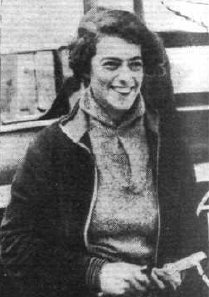Winifred Spooner facts for kids
Quick facts for kids
Winifred Evelyn Spooner
|
|
|---|---|
 |
|
| Born | 11 September 1900 Woolwich, Kent, England
|
| Died | 13 January 1933 (aged 32) |
| Nationality | British |
| Occupation | Aviator |
Winifred Evelyn Spooner (born September 11, 1900 – died January 13, 1933) was a famous English pilot. She flew planes in the 1920s and 1930s. In 1929, she won the Harmon Trophy. This award recognized her as the world's best female aviator. Winifred sadly passed away at age 32 from pneumonia.
Contents
Early Life and Learning to Fly
Winifred Spooner was born in a town called Woolwich in Kent, England. She went to school at Sherborne Girls in Dorset.
In September 1927, Winifred earned her pilot's licence. It was licence number 8137. She got it from the London Aeroplane Club. This made her only the 16th woman ever to get a pilot's licence! She also received an Aviator's Certificate in the USA. This certificate was signed by the famous Orville Wright himself.
Winifred had two brothers, Tony and Frank. They ran a business called The Polo Farm. They trained and sold horses for polo and racing. There was a field on their farm big enough for a small plane to land. So, Winifred built a wooden hangar there. She moved her own plane, a Moth, to the farm.
Winifred lived with her brothers in Wokingham for a while. She continued her "Air-Taxi Service." She would fly people around Britain and France. She also gave flying lessons. People in Wokingham remember her as one of the first women to drive a car in the area. Later, she moved to Scott's Farm near Bearwood.
Amazing Achievements in Aviation
Winifred was a very skilled pilot. She took part in many flying competitions.
In July 1928, she flew her DH.60 Cirrus I Moth plane. She came in third place in the seventh King's Cup Race. She also won the Siddeley Trophy. This was for being the first Aeroplane Club pilot to finish the race.
In 1929, she placed fifth in the King's Cup Race. This was the same year she won the Harmon Trophy. This award showed she was the world's top female pilot. She also took 10th place in the International Tourist Plane Contests Challenge.
In 1930, Winifred was part of the British team. They competed in the Challenge 1930 in Berlin, Germany. She finished seventh overall in the rally part of the contest. She ended up in a high 4th position for the whole competition. Later that year, she came fourth in a race in Italy called Giro Aereo d'Italia.
On December 5, 1930, Winifred tried to fly to South Africa in just 5 days. She was with Captain Edwards. They planned to fly day and night. After 16 hours, while Captain Edwards was flying and Winifred was asleep, their plane crashed into the sea. This happened off the coast of Belmonte Calabro in Italy. It was completely dark. Captain Edwards didn't know why the plane was losing height. He couldn't swim. So, Winifred bravely swam about 2 miles to shore. She then found local fishermen. They helped rescue Captain Edwards and the plane.
Winifred competed in three out of four F.A.I – International Tourist Plane Contests. These were the Challenge 1929, 1930, and 1932. She was one of only two women to compete. She was a top pilot, finishing 10th in 1929 and 4th in 1930. In 1932, she was 4th after the technical tests. But she had to stop after her plane made an emergency landing. This was caused by someone messing with her fuel.
In 1931, she came in fifth place in the King's Cup Race. She also became the first British woman to work as a personal pilot. She flew Sir William Lindsay Everard, who was a Member of Parliament. She flew him all over Britain, Europe, Turkey, and the Middle East.
There is a story that she crashed a plane in Cleator Moor in Cumberland, UK. The exact date is not known. But it is said she was not badly hurt, only her stockings were torn!
Her Final Days
In January 1933, Winifred caught a cold. She was at Ratcliffe Aerodrome in Leicestershire. She was usually very healthy. But her cold quickly got worse. She developed pneumonia the next day. A doctor called for a specialist from Nottingham. Sadly, there was thick fog. The specialist got lost and the oxygen he was bringing arrived too late. Winifred had a heart attack and passed away the next day, on January 13. People used to call her 'bad luck Wimpey' because she often had bad luck in races. It seemed her bad luck followed her to the very end.
Winifred was buried next to her parents. This was at St. Swithin's Church in Hinton Parva, Wiltshire. Many people attended her funeral. These included family members and important people from the aviation world.
A memorial service was held for Winifred four days later. It took place at St. Peter's in Eaton Square, London. Many people came to remember her.
Remembering Winifred
A bronze statue of Winifred Spooner was made by Donald Gilbert. It was shown to the public on May 30, 1934. Lindsay Everard MP, the person she used to fly, unveiled it. It was placed at the headquarters of the Women’s Automobile and Sports Association. An unknown person donated the statue.
Sherborne Memorial Scholarship
In 1936, Winifred's good friend, Dugald MacPherson, started a special scholarship. It was created in her memory at Sherborne School for Girls. This scholarship helps girls who show courage, independence, and generosity. These were all qualities Winifred had. The money helps a girl follow her dreams or pay for her education in a career she chooses.


